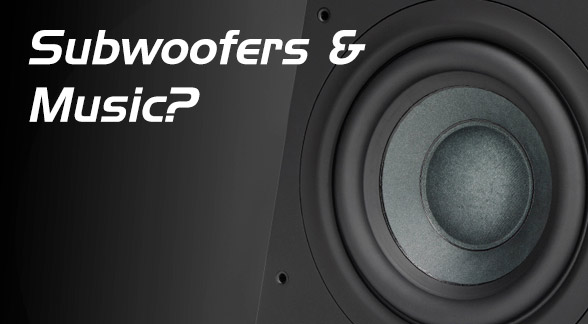Subwoofers & Music
I have a really terrific playback system in my studio. In fact, I have a couple of them and they both include the TMH “Profunder” subwoofer. There’s the main 5.1 surround music system that has 5 B&W 801 Series III speakers on anchor stands and another THX and Dolby certified theatrical setup of JBL speakers in the front and on the walls for our film mixing. They are driven by either a Bryston 7B or independent Crown amps. But the “Profunder” has got it’s own Bryston 4B pumping 250 watts into the 18″ driver in that cabinet.
Of course, I need the subwoofer for the LFE (Low Frequency Enhancement) channel when mixing for film but the question is do we really need the subwoofer when listening to music? I remember when I first started producing HD 5.1 surround mixes for our DVD-Audio projects back in the early 2000s. I received a phone call from an early adopter of the DVD-Audio format and he asked me, “Do your DVDs use the subwoofer?” I answered him that indeed we do employ send the “boom” channel or LFE to the subwoofer speaker. I also asked why he was interested. Apparently, he had purchased the Beethoven Symphonies conducted by Daniel Barenboim on Warner Brothers Records and was disappointed that his subwoofer wasn’t getting any signals when he played the symphonies. He felt that if he had purchased a nice home theater surround system that is was expected that a surround music mix should take advantage of the .1 speaker.
Some mixers don’t feel that using a channel that was really developed for motion picture soundtracks shouldn’t be used when mixing music. After all, the main speakers in a good music system can handle the low frequency information, right? Well maybe. The 12″ woofers in the B&W 801 Series III are very good drivers and extend to around 32 Hz. But I find that sending the lowest frequencies in the music I’m mixing to the “boom” output on my digital console to the “Profunder” adds to the overall impact of the low end. Without the very low bump that the TMH Labs cabinet delivers there’s just something missing.
But there are problems with using the sub for music reproduction as well. It’s usually the one speaker in the room that has its own amplification. And that means that the user can set the level to anything they want. Hardly the best solution in a well calibrated listening space. I once did a mastering and DVD job for Blue Oyster Cult in 5.1 surround. The producer got the test DVDs and complained that the low end was too loud. After several rounds of phone calls and emails, I discovered that his subwoofer was 10 dB too high! No wonder the sound was unbalanced.
So take your pick. If your main left and right speakers can handle the extreme low end then you may not need a sub for your music. But if you have a good sounding home theater and it includes a subwoofer, then I say calibrate it and deliver the .1 channel from your surround music to it.

